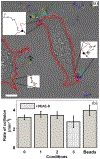Probability of Immobilization on Host Cell Surface Regulates Viral Infectivity
- PMID: 33016741
- PMCID: PMC7561012
- DOI: 10.1103/PhysRevLett.125.128101
Probability of Immobilization on Host Cell Surface Regulates Viral Infectivity
Abstract
The efficiency of a virus to establish its infection in host cells varies broadly among viruses. It remains unclear if there is a key step in this process that controls viral infectivity. To address this question, we use single-particle tracking and Brownian dynamics simulation to examine human immunodeficiency virus type 1 (HIV-1) infection in cell culture. We find that the frequency of viral-cell encounters is consistent with diffusion-limited interactions. However, even under the most favorable conditions, only 1% of the viruses can become immobilized on cell surface and subsequently enter the cell. This is a result of weak interaction between viral surface gp120 and CD4 receptor, which is insufficient to form a stable complex the majority of the time. We provide the first direct quantitation for efficiencies of these events relevant to measured HIV-1 infectivity and demonstrate that immobilization on host cell surface post-virion-diffusion is the key step in viral infection. Variation of its probability controls the efficiency of a virus to infect its host cells. These results explain the low infectivity of cell-free HIV-1 in vitro and offer a potential rationale for the pervasive high efficiency of cell-to-cell transmission of animal viruses.
Figures



References
-
- Knipe DM and Howley PM, Fields Virology, 6th ed (Wolters Kluwer/Lippincott Williams & Wilkins Health, Philadelphia, PA, 2013).
-
- Barato AC and Seifert U, Phys. Rev. Lett 114, 158101 (2015). - PubMed
-
- Ho DD and Bieniasz PD, Cell 133, 561 (2008). - PubMed
-
- Wyatt R and Sodroski J, Science 280, 1884 (1998). - PubMed
MeSH terms
Substances
Grants and funding
LinkOut - more resources
Full Text Sources
Research Materials
